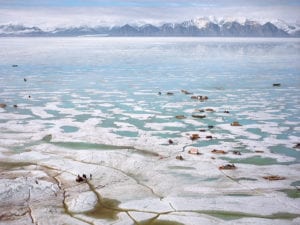Indian artist Dayanita Singh (b. 1961) is a trailblazer in photography. Since the 1980s, the Hasselblad Award-winner has pushed the limits of the way the medium is displayed – transforming black-and-white prints into three dimensional “photo-architectures”, mobile museums, montages and book objects. Crucially, Singh sees photographs as raw materials: building blocks to be rearranged, recombined and re-experienced spatially. As a major retrospective opens at Gropius Bau, Berlin, the artist talks to Aesthetica about this unique vision, exploring the role of the body in taking and experiencing pictures.
A: You trained in Visual Communication. What drew you to the medium of photography?
DS: It wasn’t really the medium of photography that drew me, rather the fact that I could be free of all the social obligations a woman had in 1980s India. I could say: “I’m a photographer so I can’t get married, I can’t have children. I need to travel; I need to live in different places.” Basically, it was a life choice that I was making. And it’s still the case: I still want to be free and not boxed in as much as possible.
A: That could be a description of how you work with photography: not only in creating but curating images. What inspired this artistic approach?
DS: I grew up around a mother who was an obsessive photographer and album maker. There were images being taken, but also something being done with the images – either they would become part of an album or were inserted onto a table covered with glass. I knew from the beginning that photography needed to be activated; it wasn’t enough to just have prints on the wall.
While I was a student, I made a book called Zakir Hussain (1986). From then on, I knew that I wanted to somehow work with books, but it was only when I made Sent a Letter (2007) that I realised I had found the way for the book itself to become the exhibition. That gave me confidence in the forms I wanted to create. The Museums [Singh made a number of works in the form of mobile museums] were important for me, because I wanted to constantly change the architecture of the space where my work was being shown. I didn’t like how photographs were fossilised on museum or gallery walls. I preferred the haptic quality of books. Museums allowed me to invite the viewer to experience the images as they would a sculpture: you have to walk around, bend down, move away, come close…

A: This process you describe, is it intuitive or more methodical?
DS: The method is in the editing. When I was working on Museum of Chance (2013), for example, it took me two years to edit a work that could be experienced in any combination. You could tell me: “Okay, show me the fifth picture, and show me the 78th picture”, and they would still work together. That’s something I have learned to do tonally by listening to my images, rather than just seeing them. I’d put prints on the table, lots of them, and then think: “what do these images want to be?” I never work on commission. It all has to come from within. I think I have developed an ear for photography.
A: It was fascinating how you described the almost choreographic way the viewer moves around your works earlier. Did that inform the exhibition title: Dancing with my Camera?
DS: Yes, but it’s also related to the fact that I’ve always wanted to teach a class called Dancing with my Hasselblad. I use my Hasselblad like an extension of my body, at the belly level. By holding the camera just below the belly button – versus your forehead – you’re engaging with a completely different nerve system. You have to move your hips to find the right angle. Your legs are the tripod. Regardless of whether I was photographing a person, or a chair, or a bottle, I’d have to do a very gentle dance around it.
A: That is such a different notion than the conventional two-dimensional image, isn’t it?
DS: Absolutely. One of the burdens of photography is that we think of it as a two dimensional medium. It’s not. It’s actually as three dimensional as any other medium. No matter how beautiful it is, no matter how strong it is in itself, to me a photograph is still just the raw material. I have to build something with that raw material. If you think of photography in this way, there are many, many more forms it can take.
Dayanita Singh: Dancing with my Camera runs until 7 August at Gropius Bau, Berlin
Words: Rachel Segal Hamilton
Image Credits:
1. Dayanita Singh, Museum of Chance, 2013
2. Dayanita Singh, Go Away Closer, 2007





